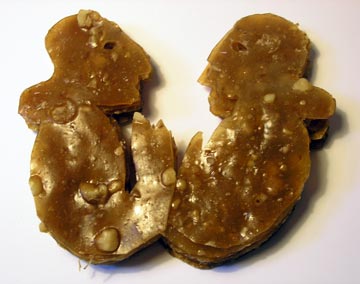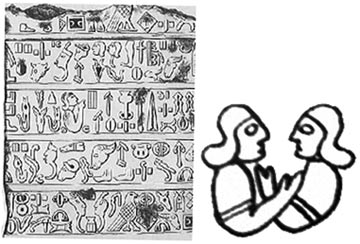Love Difference Pastries - The sweets
![]() Love to Love, by Secil Yaylali
Love to Love, by Secil Yaylali
 |
|
Sweets are our desires. We use it as a tool for basic communication in our daily lives. The abstract power of sweets can give the communities connective approach because they are gathered as the cements of relationships. They arrive today’s shape through a time process and with their histories behind. They integrate economic, social, historical and cultural aspects of their society. To work with a sweet, which is traditional, is like to reshape the memory. That is why I prefer to work on the mulberry molasses which is not a market product and homemade through a long process. Love to Love is a sweet which integrates 7 layers that are all different from each other but also same from the origin. Some of these layers are traditional tastes and some are new. The shape how the layers cut-out, comes from the hieroglyph writing that means –love-to love and also used in that region where they produce the mulberry molasses by the Hittites ages ago. It is also an open recipe that anyone who wants to add an other taste can do it as a new layer on Love to Love, it is an ongoing recipe… |
|
 The shape of two characters looking at each other is taken from the hieroglyph writing which means love - to - love and that was used by the Hittite Empire, that lived from 18th century BC to 8th Century BC in North-Central Anatolia. |
|
Ingredients: mulberry (15 kg), wheat starch (around ½ kg) , orange (3) and lemon (3), walnuts (1/2 kg), sesame (300gr) , poppy seeds (300gr) , hazelnuts (1/2 kg) :: The collected mulberries are boiled in big cupper pots. They are filtered, then the wheat starch is added step by step to the mixture and mixed very well each time. Then there will be 7 different mixtures with different integrates; as one plane, one with sesame, one with orange flavour, one walnuts, one with poppy seeds, one leman flavour and one with hazelnuts. The ones with nuts and the poppy seed had been produced for ages. The new ones are the ones with leman and orange flavours done to add some Mediterranean tastes which is not common for the location. The grated orange zest and leman lemon crusts are dried and then is added to mixture. :: These mixtures wait under the sun around 3-5 days. On the top of the flat roofs of the houses they put some clean sheets and they pour the mixture carefully as a very thin layer on the sheets. They leave the sheets on the ropes in the hot sun. After 2 days they put some water on the back side of the sheets to be able to move the molasses. :: Then these 7 layers will be put on top of each other. So all different tastes will combine with each other and as a layer they will be alone as well. The wheat starch will be put in between these layers to be able to separate them again. They will be cut by a knife in the shape of a hieroglyph writing (it is from 18-8th Century BC by Hittites and used in the region which they have the traditional of molasses now) which means –love- to love. And each piece will be placed in an envelope to give the message to the world. |
|
Secil Yaylali is a visual artist, works and
lives in Berlin and Istanbul. |
|
